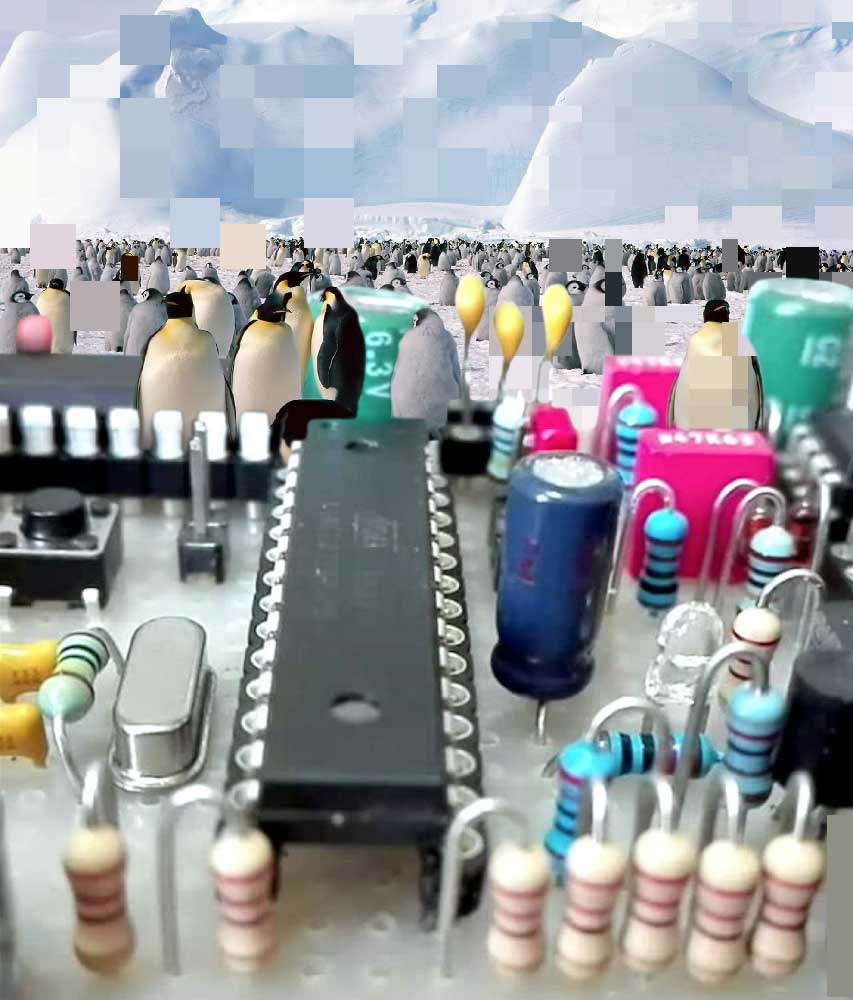Enoch's Prophecy, 2017. Digital Sketch for print production
Enoch was the grand father of Noah. He saw it coming.

Enoch's Prophecy, 2017. Digital Sketch for print production
Enoch was the grand father of Noah. He saw it coming.

Transhuman Goalie, 2017. Digital sketch
From Wikipedia: "Transhumanism (abbreviated as H+ or h+) is an international and intellectual movement that aims to transform the human condition by developing and making widely available sophisticated technologies to greatly enhance human intellect and physiology.[1][2]"
What does it mean to enhance the human being? In my experience, weaknesses are a gift for personal reflection and spiritual growth. Will enhanced people be more superficial; and if so, what is "enhanced" about that?

Black Power Capacitor, 2017. Digital sketch (photo collage)
Speak your truth, digitize it, post it online, and change global consciousness. The power of digital is political power. For what do you stand?

Consider the physical and software prep work that we do to create our social media presence. As the Internet progressively invades our psyche, online identity is a major component of ego. Are we the same person in physical reality as we are online, or is there a new dichotomy of self? Where is the real me?

The Kiss, 2017. Digital image (sketch) for mixed media production.
I continue to sketch in software to build up a portfolio of images, the best of which I will select for mixed media production. I am meanwhile developing a new technique that combines inkjet printing, image transfer, screen printing, and layered acrylic painting. My goal is to reproduce a multi-layered Photoshop aesthetic but with trace of the a human hand. Inkjet printing alone is not enough for me.
I've been studying Imago relationship theory lately. My readings inspired this image. Here's a summary of Imago pulled from Wikipedia:
"Imago therapy focuses on collaboratively healing childhood wounds couples share.[5] According to Hendrix and Hunt, the human brain has a compelling non-negotiable drive to restore feelings of aliveness and wholeness with which people came into the world.[9] It is believed by imago therapists that a person's brain constructs an image of characteristics from their primary caretakers including both their best and worst traits.[10] The brain's unconscious drive is to repair damage done in childhood, needs not met, by finding a partner who can give us what our caretakers failed to provide.[9] This is why traits of a future partner often reflect our parents' traits. Our unconscious drives towards this to seek healing and to resolve unresolved childhood wounds, in order to grow. In this way, wounds received by a person, from their parents, tend to be re-stimulated by new adult partners and potential partners. The re-stimulation triggers old, unresolved emotions. Both people in the relationship can learn how to heal one another, and appreciate each other for the person they are--and--it takes time. Couples must engage in a specific type of dialogue for Imago therapy to work. The conscious self may not be able to see and understand clearly the reflection of unresolved parental issues in his or her current marriage partner. Nonetheless, our unconscious connects with this person in its best (unconscious) effort to heal old wounds and allow love into your life again.[citation needed]"

Celebrity Mug Shot, 2017. Digital photo collage based on Justin Bieber's brush with the law
After my depressing post about penguins, I offer a little levity: SpongeBob without make-up.


Kelly Heaton, "Climate Change (Penguins)," 2017. Digital photocollage comprised of an electronic circuit, a photo of Emperor Penguins in Antarctica, and pixel manipulation
By Lakshmi SupriyaJul. 7, 2017 , 10:30 AM
Emperor penguins are known for braving the harsh Antarctic winters, but they might not be able to brave the harsh realities of climate change. That’s the finding of a new study, which suggests that by the end of this century, the world’s largest penguins may be no more. Previous research suggested that rapidly warming air and sea temperatures—which melt sea ice—might cause their numbers to plummet by as much as 19% by 2100. But a new model looks at other factors, including how individual penguins deal with climate change by migrating to places with optimal sea ice coverage. In their model of potential penguin migrations, researchers looked at how far penguins typically go and what factors figure in their decisions. They used data previously collected from Pointe Géologie in Antarctica along with satellite images of penguin colonies that revealed information about their traveling and foraging behavior. The model projects that for the next 2 decades, populations will remain stable, and may even increase slightly as the penguins move to locations that are more habitable. After 2050, it all goes downhill. Although the rate of population decline may vary, by the year 2100 almost all emperor penguins may be gone, the researchers write in an upcoming issue of Biological Conservation. That’s because climate change will have rendered all their habitats inhospitable by then. Gaining endangered status under the U.S. Endangered Species Act, the scientists say, may be one way of arresting what might otherwise be their final march.
Posted in:
DOI: 10.1126/science.aan7070
http://www.sciencemag.org/news/2017/07/emperor-penguins-may-disappear-end-century